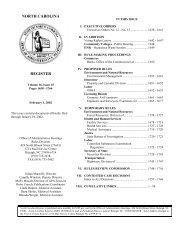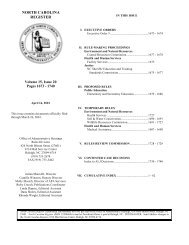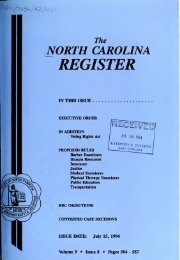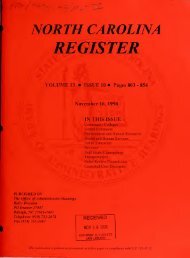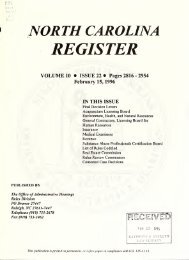NC Register Volume 24 Issue 19 - Office of Administrative Hearings
NC Register Volume 24 Issue 19 - Office of Administrative Hearings
NC Register Volume 24 Issue 19 - Office of Administrative Hearings
You also want an ePaper? Increase the reach of your titles
YUMPU automatically turns print PDFs into web optimized ePapers that Google loves.
APPROVED RULES<br />
deterministic) and the sensitivity testing done<br />
relative to those scenarios. If negative ending<br />
surplus results under any tests in the aggregate,<br />
the actuary shall describe those tests and the<br />
amount <strong>of</strong> additional reserve as <strong>of</strong> the<br />
valuation date that, if held, would eliminate<br />
the negative aggregate surplus values. Ending<br />
surplus values shall be determined by either<br />
extending the projection period until the in<br />
force and associated assets and liabilities at the<br />
end <strong>of</strong> the projection period are considered by<br />
the appointed actuary to be immaterial or by<br />
adjusting the surplus amount at the end <strong>of</strong> the<br />
projection period by an amount that<br />
appropriately estimates the value that can<br />
reasonably be expected to arise from the assets<br />
and liabilities remaining in force;<br />
(2) The extent to which the appointed actuary uses<br />
assumptions in the asset adequacy analysis that<br />
are considered by the appointed actuary to be<br />
materially different than the assumptions used<br />
in the previous asset adequacy analysis;<br />
(3) The amount <strong>of</strong> reserves and the identity <strong>of</strong> the<br />
product lines that had been subjected to asset<br />
adequacy analysis in the prior opinion but<br />
were not subject to analysis for the current<br />
opinion;<br />
(4) Comments on any interim results that may be<br />
<strong>of</strong> concern to the appointed actuary, such as<br />
the effect <strong>of</strong> the insufficiency <strong>of</strong> assets to<br />
support the payment <strong>of</strong> benefits and expenses<br />
and the establishment <strong>of</strong> statutory reserves<br />
during one or more interim periods;<br />
(5) The methods used by the actuary to recognize<br />
the impact <strong>of</strong> reinsurance on the company's<br />
cash flows, including both assets and<br />
liabilities, under each <strong>of</strong> the scenarios tested;<br />
and<br />
(6) Whether the actuary has been satisfied that all<br />
options whether explicit or embedded, in any<br />
asset or liability (including those affecting<br />
cash flows embedded in fixed income<br />
securities) and equity-like features in any<br />
investments have been appropriately<br />
considered in the asset adequacy analysis.<br />
(d) The regulatory asset adequacy issues summary shall contain<br />
the name <strong>of</strong> the company for which the regulatory asset<br />
adequacy issues summary is being supplied, and shall be signed<br />
and dated by the appointed actuary rendering the actuarial<br />
opinion.<br />
(e) The memorandum shall include a statement:<br />
"Actuarial methods, considerations and analyses used in<br />
the preparation <strong>of</strong> this memorandum conform to the<br />
appropriate Standards <strong>of</strong> Practice as promulgated by the<br />
Actuarial Standards Board, which standards form the<br />
basis for this memorandum."<br />
(f) An appropriate allocation <strong>of</strong> assets in the amount <strong>of</strong> the<br />
interest maintenance reserve (IMR), whether positive or<br />
negative, shall be used in any asset adequacy analysis. Analysis<br />
<strong>of</strong> risks regarding asset default may include an appropriate<br />
allocation <strong>of</strong> assets supporting the asset valuation reserve<br />
(AVR); these AVR assets may not be applied for any other risks<br />
with respect to reserve adequacy. Analysis <strong>of</strong> these and other<br />
risks may include assets supporting other mandatory or<br />
voluntary reserves available to the extent not used for risk<br />
analysis and reserve support. The amount <strong>of</strong> the assets used for<br />
the AVR shall be disclosed in the table <strong>of</strong> reserves and liabilities<br />
<strong>of</strong> the opinion and in the memorandum. The method used for<br />
selecting particular assets or allocated portions <strong>of</strong> assets shall be<br />
disclosed in the memorandum.<br />
(g) The appointed actuary shall retain on file, for at least seven<br />
years, all documentation necessary to determine the procedures<br />
followed, the analyses performed, the bases for the assumptions,<br />
and the results obtained.<br />
History Note: Authority G.S. 58-2-40; 58-58-50(i); 58-58-<br />
50(j);<br />
Eff. December 1, <strong>19</strong>94;<br />
Amended Eff. March 1, 2010; August 1, 2004.<br />
11 <strong>NC</strong>AC 11F .0403 BASIC AND PREMIUM<br />
DEFICIE<strong>NC</strong>Y RESERVES<br />
(a) At the election <strong>of</strong> the company for any one or more specified<br />
plans <strong>of</strong> life insurance, the minimum mortality standard for basic<br />
reserves may be calculated using the <strong>19</strong>80 CSO valuation tables<br />
with select mortality factors (or any other valuation mortality<br />
table adopted by the NAIC after January 1, 2000, and adopted as<br />
a rule by the Commissioner for this purpose). If select mortality<br />
factors are elected, they may be:<br />
(1) The ten-year select mortality factors<br />
incorporated into the <strong>19</strong>80 amendments to the<br />
NAIC Standard Valuation Law;<br />
(2) The select mortality factors in the NAIC<br />
Model Regulation entitled "Valuation <strong>of</strong> Life<br />
Insurance Policies Model Regulation"; or<br />
(3) Any other table <strong>of</strong> select mortality factors<br />
adopted by the NAIC after January 1, 2000,<br />
and adopted as a rule by the Commissioner for<br />
the purpose <strong>of</strong> calculating basic reserves.<br />
(b) Deficiency reserves, if any, are calculated for each policy as<br />
the excess, if greater than zero, <strong>of</strong> the quantity A over the basic<br />
reserve. The quantity A is obtained by recalculating the basic<br />
reserve for the policy using guaranteed gross premiums instead<br />
<strong>of</strong> net premiums when the guaranteed gross premiums are less<br />
than the corresponding net premiums. At the election <strong>of</strong> the<br />
company for any one or more specified plans <strong>of</strong> insurance, the<br />
quantity A and the corresponding net premiums used in the<br />
determination <strong>of</strong> quantity A may be based upon the <strong>19</strong>80 CSO<br />
valuation tables with select mortality factors (or any other<br />
valuation mortality table adopted by the NAIC after January 1,<br />
2000, and adopted as a rule by the Commissioner). If select<br />
mortality factors are elected, they may be any <strong>of</strong> the following:<br />
(1) The ten-year select mortality factors<br />
incorporated into the <strong>19</strong>80 amendments to the<br />
NAIC Standard Valuation Law;<br />
(2) The select mortality factors in the NAIC<br />
Model Regulation entitled "Valuation <strong>of</strong> Life<br />
Insurance Policies Model Regulation";<br />
<strong>24</strong>:<strong>19</strong> NORTH CAROLINA REGISTER APRIL 1, 2010<br />
1704




